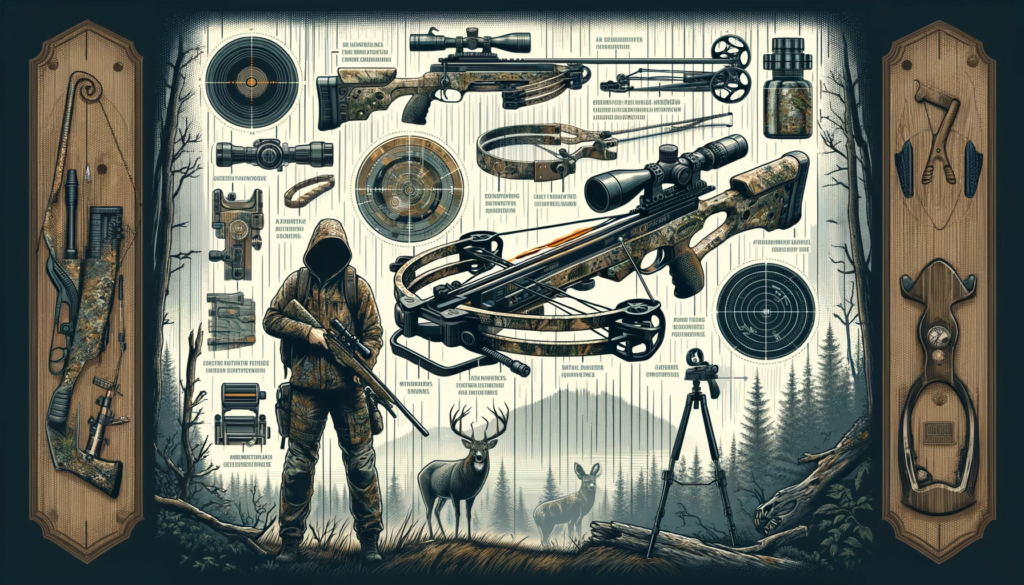Crossbow Hunting Tips: Mastering the Silent Shot

Crossbow Hunting Tips: Transitioning into the realm of crossbow hunting offers a thrilling fusion of ancient methods and contemporary accuracy. As you embark on this captivating journey, it’s essential to arm yourself with knowledge. Thus, here’s a comprehensive guide to enhance your prowess in crossbow hunting.
Table of Contents
1. The Anatomy of a Crossbow
- Understanding Components: A crossbow comprises the stock, limbs, string, rail, trigger mechanism, and optics. Familiarize yourself with each to optimize performance.
- Choosing the Right Crossbow: Picking a crossbow isn’t one-size-fits-all. Assess the draw weight, size, and speed, balancing comfort with performance.
- Maintenance Prowess: Regular inspections for wear and tear, coupled with thorough cleaning and lubrication, ensure longevity and consistent performance.
- Master Your Range: Every crossbow has a specific effective range. While 40 yards is typical, understanding your individual weapon’s capabilities is paramount.
2. Form, Stance, and Grip
- Stance Strategies: A solid stance is your foundation. Whether you opt for open or closed, consistency is vital.
- The Grip Grasp: Torque is the enemy of accuracy. A gentle, relaxed grip with the crossbow’s fore-end resting on your hand ensures minimal torque.
- Eye for Precision: Proper eye alignment with the scope or sights is crucial. Train your dominant eye to enhance accuracy.
3. The Art and Science of Practice
- Commit to Consistency: Frequency in target practice sessions solidifies muscle memory, fostering instinctual shooting.
- Weather the Storm: Don’t shy away from practicing in varying conditions. Wind, rain, and diverse terrains can offer invaluable experience.
- Embrace Challenges: Incorporate moving targets, varying distances, or even blindfolded shooting to push your skills.
4. Camouflage and Concealment
- Nature’s Apprentice: Limit your scent and move stealthily. Consider scent eliminators and natural covers.
- Dressing the Part: A matching camouflage outfit is more than fashion—it’s functional. Ensure it blends seamlessly with your environment.
- Minimized Movement: Be patient and avoid unnecessary movements. The less you move, the less detectable you are.
5. Shot Placement and Ethics
- Vital Aiming: An ethical hunter aims for a swift kill. Understand your target’s anatomy, focusing on vital areas for a humane hunt.
- Wait, Breathe, Release: It’s tempting to rush, but patience often ensures a clean, accurate shot.
- Bolt Dynamics: Recognize the arcing trajectory of crossbow bolts, adjusting your aim based on distance.
6. Safety Protocols
- Loaded with Caution: Adopt the mindset that your crossbow is always loaded to minimize accidents.
- Finger Placement: Keep fingers below the flight deck. A misplaced finger can lead to painful injuries.
- Equipment Check: Beyond the crossbow, regularly inspect bolts, strings, and accessories for optimal safety.
7. Prey Intel
- Study Patterns: Whether it’s deer, elk, or smaller game, research their habits for an edge.
- Tracking Techniques: From footprints to scat, hone your tracking skills to stay on your prey’s tail.
- The Call of the Wild: Different animals respond to varied calls. Learn to mimic or invest in effective game calls.
8. Weather Adaptations
- Navigating the Wet: Rain can affect a bolt’s flight. Waterproofing equipment can offer an edge.
- Winds of Change: Wind calculations can be the difference between a miss and a hit. Always assess the wind direction and speed.
- Cold Challenges: Low temperatures can stiffen crossbow components. Ensure it’s well-lubricated and store in moderate temperatures when not in use.
9. Transport and Storage
- Invest in Protection: Furthermore, a high-quality case not only protects your crossbow from potential damage but also from the elements.
- Safe De-cocking: Learn the safest methods to de-cock without discharging a bolt unnecessarily.
- Legal Labyrinths: Local laws can vary. Always be compliant when transporting and storing.
10. Continued Education
- Evolution of Crossbow Tech: Stay updated. As technology advances, so do crossbow designs and capabilities.
- Community Connect: Engage in forums, clubs, and local groups. Shared knowledge often provides invaluable insights.
- Embrace Errors: Mistakes offer growth. Reflect on failed hunts or misses as learning curves.
Conclusion:
Crossbow Hunting Tips: Crossbow hunting offers a unique blend of skill, patience, and technology. Firstly, by honing your techniques, you lay the foundation for a successful hunt. Additionally, staying informed can prove beneficial. Therefore, whether you’re a novice or a seasoned veteran, embracing these insights can greatly elevate your hunting experiences.
FAQs
- Are crossbows as powerful as firearms?
- While they can be lethal, their power doesn’t typically match firearms. They are, however, quieter and suitable for specific hunting scenarios.
- How often should bolts be replaced?
- It depends on usage. Regularly inspect for any deformities, but as a rule, after any impact or potential damage, consider replacement.
- What’s the lifespan of a modern crossbow?
- With proper maintenance, a crossbow can last for several years, if not a decade. However, components like strings might need periodic replacements.
- How does weather affect a crossbow’s accuracy?
- Rain can dampen strings, affecting shot speed. Cold can stiffen components, and wind can divert bolts. Always adjust techniques and expectations accordingly.
- Any tips for nighttime crossbow hunting?
- Yes, invest in quality optics with night vision or illuminated reticles, move silently, and know your surroundings well to ensure safety.
This guide serves as a holistic manual for crossbow enthusiasts. Here’s to many successful hunts ahead!







